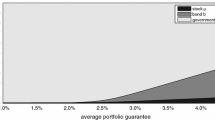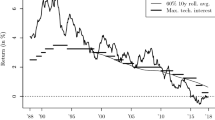Abstract
This paper examines the profit testing of life insurance companies that issue participating policies, type B and type A universal life policies, and variable annuities with guaranteed minimum maturity and death benefits, when investment returns are stochastic and modeled by normal or variance gamma distributions. We rely on the stochastic profit testing techniques introduced in Dickson et al. (Actuarial mathematics for life contingent risks, 2nd edn, Cambridge University Press, Cambridge, 2013) to examine the influence of the models’ parameters and of the models themselves on the profit testing indicators. We show that the variance gamma model results in more conservative predictions than the normal model for most cases.


































Similar content being viewed by others
Notes
We first write:
$$\begin{aligned} V_{t-1}=S\left( A_{x+t-1}-\frac{A_x}{\ddot{a}_{x}}\ddot{a}_{x+t-1}\right) . \end{aligned}$$Then, we observe that
$$\begin{aligned} V_{t-1}=S\left( 1-(1-v_V)\ddot{a}_{x+t-1}-(1-(1-v_V)\ddot{a}_x)\frac{\ddot{a}_{x+t-1}}{\ddot{a}_{x}}\right) =S\left( 1-\frac{\ddot{a}_{x+t-1}}{\ddot{a}_{x}}\right) . \end{aligned}$$
References
Akaike, H.: A new look at the statistical model identification. IEEE Trans. Autom. Control 19, 716–723 (1974)
Applebaum, D.: Lévy Processes and Stochastic Calculus, Cambridge Studies in Advance Mathematics, 2nd edn. Cambridge University Press, Cambridge (2009)
Ballotta, L., Bonfiglioli, E.: Multivariate asset models using Lévy processes and applications. Eur. J. Finance 22, 1320–1350 (2016)
Ballotta, L., Haberman, S., Wang, N.: Guarantees in with-profit and unitized wth-profit life insurance contracts: fair valuation problem in presence of the default option. J. Risk Insur. 73, 97–121 (2006)
Belth, J.M.: A note on disclosure of realized rates of return for retirement accumulations, savings accounts, and the savings component of universal life insurance policies. J. Risk Insur. 49, 613–617 (1982)
Carr, P., Chang, E., Madan, D.: The variance gamma process and option pricing. Eur. Finance Rev. 2, 79–105 (1998)
Carson, J.: Determinants of universal life insurance cash values. J. Risk Insur. 63, 673–681 (1996)
Cherin, A.C., Hutchins, R.C.: The rate of return on universal life insurance. J. Risk Insur. 54, 691–711 (1987)
Chung, Y., Skipper, H.: The effect of interest rates on surrender values of universal life policies. J. Risk Insur. 54, 341–347 (1987)
Da Fonseca, J., Ziveyi, J.: Valuing variable annuity guarantees on multiple assets. Scand. Actuar. J. 2017, 209–230 (2017)
D’Agostino, L.: Life insurance profit testing in the Solvency II framework. Banca Impresa Società 1, 43–78 (2014)
D’Arcy, S.P., Lee, K.C.: Universal/variable life insurance versus similar unbundled investment strategies. J. Risk Insur. 54, 452–477 (1987)
D’Arcy, S.P., Lee, K.C.: The optimal investment strategy through variable universal life insurance. J. Risk Insur. 56, 201–217 (1989)
Dickson, D.C.M., Hardy, M.R., Waters, H.R.: Actuarial Mathematics for Life Contingent Risks, 2nd edn. Cambridge University Press, Cambridge (2013)
Eberlein, E., Raible, S.: Term structure models driven by general Lévy processes. Math. Finance 9, 31–54 (1999)
Eberlein, E., Oezkan, F.: The defaultable Lévy term structure: ratings and restructuring. Math. Finance 13, 277–300 (2003)
Eberlein, E., Madan, D.: On Correlating Lévy Processes. Robert H, Smith School Research Paper (2009)
Gao, J., Ulm, E.: Optimal consumption and allocation in variable annuities with guaranteed minimum death benefits. Insur.: Math. Econ. 51, 586–598 (2012)
Gatzert, N., Kling, A.: Analysis of participating life insurance contracts: a unification approach. J. Risk Insur. 74, 547–570 (2007)
Gatzert, N., Schmeiser, H.: Assessing the risk potential of premium payment options in participating life insurance contracts. J. Risk Insur. 75, 691–712 (2008)
Gatzert, N., Schmitt-Hoermann, G.: Understanding the death benefit switch option in universal life policies. J. Risk Insur. 78, 823–852 (2011)
Hoyt, R.: Modeling insurance cash flows for universal life policies. J. Actuar. Pract. 2, 197–220 (1994)
Kallsen, J., Tankov, P.: Characterization of dependence of multidimensional L\(\acute{e}\)vy processes Using L\(\acute{e}\)vy Copulas. J. Multivar. Anal. 97, 1551–1572 (2006)
Kelani, A., Quittard-Pinon, F.: Pricing and hedging variable annuities in a Lévy market: a risk management perspective. J. Risk Insur. 84, 209–238 (2017)
Le Courtois, O., Walter, C.: The computation of risk budgets under the Lévy process assumption. Revue Finance 35, 87–108 (2014)
Le Courtois, O., Xu, X.: Efficient portfolios and extreme risks: a Pareto–Dirichlet approach. Ann. Oper. Res. (2023)
Madan, D., Seneta, E.: The variance gamma (V.G.) model for share market returns. J. Bus. 63, 511–524 (1990)
Madan, D., Milne, F.: Option pricing with VG martingale components. Math. Finance 1, 39–55 (1991)
Ng, A.-Y., Li, J.-H.: Pricing and hedging variable annuity guarantees with multiasset stochastic investment models. N. Am. Actuar. J. 17, 41–62 (2013)
Schwarz, G.: Estimating the dimension of a model. Ann. Stat. 6, 461–464 (1978)
Valkenburg, F.R.: Managers Do Not Lean Back. A Profit Testing Model that Evaluates Scenario Dependent Management Dicision. AFIR Colloquium Nurnberg, Germany, pp. 545–572 (1996)
Vuong, Q.H.: Likelihood ratio tests for model selection and non-nested hypotheses. Econometrica 57(2), 307–333 (1989)
Author information
Authors and Affiliations
Corresponding author
Additional information
Publisher's Note
Springer Nature remains neutral with regard to jurisdictional claims in published maps and institutional affiliations.
Appendix
Appendix
In this appendix, we deduct the expression of Eq. (11) by using two representations of the variance gamma process. The first of these representations is Eq. (4), while the second of these representations is a Brownian motion W(t) with drift \(\theta t\), both subject to a random time change that follows a gamma process, as in Carr et al. (1998):
where \(\Gamma \left( \frac{1}{\nu },\frac{1}{\nu }\right) \) is a gamma random variable with shape and size parameters both equal to \(\frac{1}{\nu }\).
From Applebaum (2009), Eq. (21) can also be written as
where \(\mu _p=\frac{1}{2}\sqrt{\theta ^2+\frac{2\zeta ^2}{\nu }}+\frac{\theta }{2}\) and \(\mu _q=\frac{1}{2}\sqrt{\theta ^2+\frac{2\zeta ^2}{\nu }}-\frac{\theta }{2}\).
Then, Eqs. (4) and (22) can be linked as follows:
We now model the correlated variance gamma processes. We use the representation in Eberlein and Madan (2009) that yields:
where \(Z_i\) are standard normal variables with correlation \(\rho '\).
We denote \(\Gamma _i=\Gamma \left( \frac{1}{\nu _i},\frac{1}{\nu _i}\right) \) and obtain:
where
and where \({\widetilde{\Gamma }}(\cdot )\) is the gamma function.
Using the parametrization of Eq. (4), we already know that
where \(\rho \) is the correlation between the two returns \(VG_1\) and \(VG_2\). \(\rho '\) can be expressed explicitly as a function of the parameters \((\mu ^v_i,\eta _i,\alpha _i,\beta _i)\):
Finally, we substitute the Eq. (23) into the Eq. (24) and we obtain Eq. (11).
Rights and permissions
Springer Nature or its licensor (e.g. a society or other partner) holds exclusive rights to this article under a publishing agreement with the author(s) or other rightsholder(s); author self-archiving of the accepted manuscript version of this article is solely governed by the terms of such publishing agreement and applicable law.
About this article
Cite this article
Le Courtois, O., Shen, L. Profit testing of profit sharing life insurance policies when asset returns are variance gamma distributed. Decisions Econ Finan (2024). https://doi.org/10.1007/s10203-024-00440-6
Received:
Accepted:
Published:
DOI: https://doi.org/10.1007/s10203-024-00440-6
Keywords
- Profit testing
- Participating contract
- Universal life contract
- Variable annuities with guarantees
- Gaussian and non-Gaussian assumptions
- Variance gamma process




